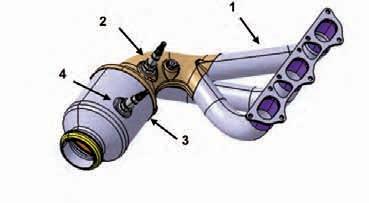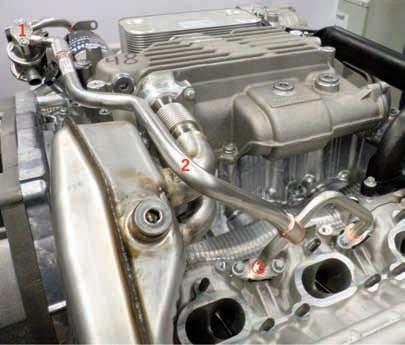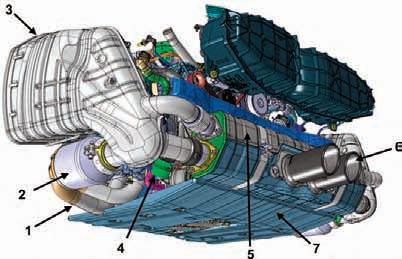
3 minute read
2.6 Exhaust system
The sports exhaust system of the 911 GT3 is similar to the previous model. The 911 GT3 (991) also has high-performance manifolds, two close-coupled catalytic converters integrated in the manifolds as well as two switchable front mufflers and one rear muffler with two central tailpipes. The high-performance manifolds have been redesigned and are now even more efficient thanks to the merging of the individual tailpipes to achieve improved air flow characteristics.
Emission control/catalytic converter
A ceramic catalytic converter with 400 cells is installed at the end of the exhaust manifold on each cylinder bank for emission control.

Manifold with catalytic converter
02_20_14
1 - High-performance manifold 2 - Broadband oxygen sensor (LSU) upstream of catalytic converter 3 - Catalytic converter 4 - Two-point step oxygen sensor (LSF) downstream of catalytic converter DME Engine electronics 2
DME Engine electronics 2

To comply with country-specific emission standards, the 991 GT3 features secondary-air injection worldwide. With secondary-air injection, the heat that is released during post-combustion at a low engine load during the first 30 seconds after a cold start is used for targeted heating of the catalytic converters in order to reach the conversion temperature quickly.
1 - Check valve for secondary air 2 - Line to cylinder bank 3 - Cylinder head on exhaust side
The electric secondary-air pump is located behind the intake manifold on cylinder bank 1. When the secondary-air pump is activated, secondary air is routed via a check valve (1) behind the exhaust valves into the cylinder head.

Secondary-air routing 02_21_14
To achieve high engine power, the front mufflers can be activated and deactivated by way of two map-controlled vacuum driven exhaust flaps. When these flaps are closed, the exhaust gas is routed exclusively via the front muffler to the main muffler. When the exhaust flaps open, this provides a direct passage to the main muffler, resulting in a reduction in exhaust backpressure and a further increase in engine power. The exhaust flaps are controlled according to the prevailing loads and engine speeds.
1 - High-performance manifold 2 - Catalytic converter 3 - Front muffler 4 - Diaphragm cell for switching the exhaust flap 5 - Main muffler 6 - Exhaust tailpipes 7 - Underbody panelling

Air cleaner/catalytic converter/exhaust system 02_22_14 DME Engine electronics 2

DME Engine electronics 2

Like its predecessor, the 911 GT3 (991) has a function for increasing torque in the middle rpm range. This function is not activated by pressing a SPORT button as was the case for the previous model, but instead using the button with the twin tailpipe symbol (1) in the center console. When this button is pressed, the torque is increased in the middle rpm range. The exhaust backpressure in the variable exhaust system is additionally reduced and the gas cycle is improved, resulting in a noticeable boost in torque in the rpm range between approximately. 3,000 and 4,000 rpm. The torque levels are increased by between approximately 22 and 26 ft. lb. (30 and 35 Nm). The maximum torque of 325 ft. lb. (440 Nm) at 6,250 rpm remains unchanged.
The switching point of the exhaust flaps depends on the load and engine speed. As on the 997 GT3 II, the switching point from closed to open at full throttle is 3,200 rpm (exhaust flap button (1) pressed) and 4,000 rpm (exhaust flap button (1) not pressed).

Center console 02_23_14
Exhaust tailpipes
The outer diameter of the central tailpipes has been enlarged from 80 mm (997 GT3 II) to 90 mm and their length has been adapted for the new rear apron.









